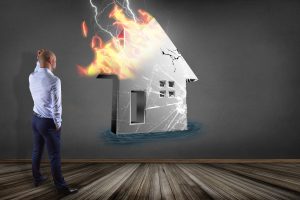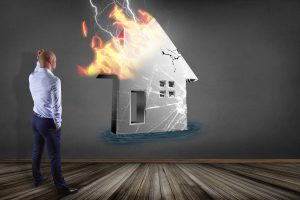 Climate change does not seem to be playing into homebuyers decisions on where they are purchasing homes according to Redfin, as nearly 400,000 more people moved into than out of the most flood-prone counties in 2021 and 2022—an increase of 103% when 189,000 moved into these areas in the two years prior.
Climate change does not seem to be playing into homebuyers decisions on where they are purchasing homes according to Redfin, as nearly 400,000 more people moved into than out of the most flood-prone counties in 2021 and 2022—an increase of 103% when 189,000 moved into these areas in the two years prior.
The trend of moving into disaster-prone areas posted similar results for areas known to be vulnerable to wildfires and extreme heat.
So why are people choosing to move into these places? According to Redfin, the housing affordability crisis exacerbated by the pandemic era homebuying boom led Americans into these disaster-prone areas.
According to a Redfin analysis of domestic migration data, which used U.S. Census Bureau data and climate risk scores from the First Street Foundation found that the counties with the highest wildfire risk saw 446,000 more people move in than out over the past two years, a 51% increase from 2019 and 2020. And the counties with the highest heat risk saw 629,000 more people move in than out, a 17% uptick.
Redfin continued by saying remote work and record-low mortgage rates during the pandemic prompted scores of Americans to leave expensive coastal cities like San Francisco and New York for the Sun Belt in search of more affordable housing, warm weather and/or lower taxes. States including Florida, Texas, and Arizona exploded in popularity despite increasing climate change risk from storms, drought, wildfires, and extreme heat.
“It’s human nature to focus on current benefits, like waterfront views or a low cost of living, over costs that could rack up in the long run, like property damage or a decrease in property value,” said Redfin Chief Economist Daryl Fairweather. “It’s also human nature to discount risks that are tough to measure, like climate change.”
Disaster-prone areas are relatively affordable because homebuyers and renters have a larger pool of homes to choose from; developers and individuals are increasingly building housing in these areas because of the cheaper land; more than half (55%) of homes built so far this decade face fire risk, while 45% face drought risk, a separate Redfin analysis found. By comparison, just 14% of homes built from 1900 to 1959 face fire risk and 37% face drought risk. New homes are also more likely than older homes to face heat and flood risk.
“The consequences of climate change haven’t fully sunk in for many Americans because oftentimes, homeowners and renters don’t foot the whole bill when disaster strikes,” Fairweather said. “Insurers and government programs frequently subsidize the cost of rebuilding after storms hit, and mortgages mean homeowners are ceding some risk to lenders—especially if their house goes into foreclosure after a storm. But with natural disasters intensifying and insurers pulling out of disaster-prone areas including Florida and California, Americans may start feeling a greater sense of urgency to mitigate climate dangers—especially if their home’s value is at risk of declining.”
Redfin further said that nearly half (48.7%) of people who moved in the last year believe the increasing frequency or intensity of natural disasters, extreme temperatures, and/or rising sea levels will likely impact home values in their area in the next 10 years, according to a recent Redfin survey. Still, only about 5% of people who moved in the last year or plan to move in the next year listed climate change as a reason for their relocation.
Looking at one flood and storm prone state in particular—Florida—during the past two years, nearly 60,000 more people moved into Lee County, Florida than moved out, and that was after it was ravaged by Hurrican Ian last September. That’s the largest net inflow of the 306 high-flood-risk counties Redfin analyzed and represents an increase of about 65% from the prior two years.
Even though ample data is available to the public, homebuilders continue to build and homebuyers continue to buy. The Cape Coral metro area has more than made up for the plunge in new listings caused by the storm, and home sales have also rebounded, a separate Redfin analysis found.
“Builders in Cape Coral have not stopped—they’re just building like nothing happened,” said local Redfin Premier real estate agent Isabel Arias-Squires. “That’s largely because there’s plenty of demand for new homes. Many folks who moved into Florida from the Northeast or the West during the pandemic are leaving, but they’re quickly being replaced by new out-of-staters. Some people just want to be on the water no matter what, and/or they want to move here for family, weather or political reasons. The Cape is not slowing down.”
But recent news could put a stop to some of this growth due to a number of home and mortgage insurance carriers pulling out of areas deemed unprofitable due to climate change. People are still moving to Florida, but they’re leaving Louisiana, which has the highest concentration of high-risk homes.
Nearly every home in Orleans Parish and Jefferson Parish—the areas including and surrounding New Orleans—faces high flood risk. Both saw roughly 15,000 more people move out than in over the past two years, adding to outflows from the prior two years.
“The rise in homeowners insurance rates across Louisiana is decreasing the amount of money people have to put toward buying a home, diminishing their purchasing power,” said local Redfin Premier real estate agent Jes Menes. “Elevated insurance costs are also driving some landlords to increase rents, making housing more expensive for tenants.”
The same trends are seen in fire-prone areas in California, Utah, and Arizona; nearly 40,000 more people have moved into Riverside County, California than out in the past two years.
Fairweather has her own climate migration story. She left Seattle in 2020 to escape wildfire smoke and moved to Wisconsin. It was free from smoke for the first few years she was there, but this June was hit with four days of unhealthy smoke from wildfires in Canada.
“There’s nowhere to hide,” Fairweather said. “Every place on planet earth will have to deal with the ramifications of climate change. The Midwest may be insulated from sea level rise, but it still faces risk from storms, heat waves and drought.”
Click here to view the report in its entirety.






